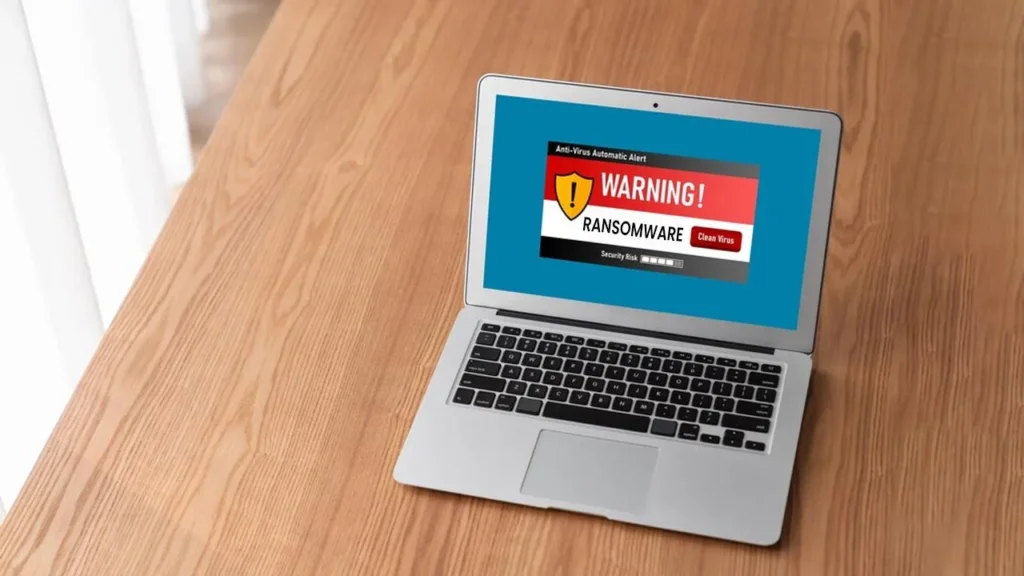Ransomware is a malicious program and a huge threat to enterprises. It encrypts files and systems, demanding ransom payments to restore access. As attacks grow more prevalent and sophisticated, understanding ransomware types, infection methods, and protection best practices becomes critical knowledge for organization to avoid operational, financial, and legal consequences. Failing to stay ahead of these evolving threats can lead to devastating data loss and long-term reputational damage, making cybersecurity vigilance more essential than ever.
Types of Ransomware

There are various types of ransomware, each with its own characteristics and avenues for infiltrating systems:
- Crypto Ransomware: Encrypts files/drives using complex methods difficult to crack. Prevents access to data fully until the decryption key is provided after the ransom is paid.
- Locker Ransomware: Locks users out of entire systems like laptops or phones until ransom is met. More destructive as device access gets blocked.
- Scareware: Poses falsely as legitimate software like antivirus protection. Once downloaded, it encrypts files or claims illegal activity was detected to extort money.
- Doxware or Leakware: Exfiltrates sensitive data threatening to publish or leak stolen company information publicly if ransom goes unpaid. Extortion tactic applies reputation pressure.
How Ransomware Spreads

Ransomware leverages multiple routes to slip past defenses and download onto systems where it then self-propagates rapidly encrypting connected drives/networks:
- Phishing Emails: Links or attachments in emails manually downloaded by recipients serve as the main infection method. Social engineering fools people into activating malicious scripts.
- Malicious Websites: Infected sites inject ransomware onto visitor devices effortlessly without clicks needed due to drive-by-downloads exploiting unpatched browser/OS flaws.
- Software Vulnerabilities: Hackers penetrate networks via unsecured ports and then unleash viruses attacking internal weaknesses to spread exponentially between endpoints and backups.
- Remote Desktop Protocol (RDP) Surfaces: Hackers find exposed management interfaces connected via RDP and then brute force weak login credentials to gain initial access needed to enable ransomware transmission remotely.
- Social Engineering: Attackers persuade employees to bypass security policies and protocols through psychological manipulation in person or over communication channels.
The Impact of Ransomware Attacks
The consequences of a successful ransomware attack can severely devastate businesses in multiple ways both immediately and through lingering aftereffects:
- Financial Losses: Direct costs of extorted ransom demands plus downtime impacts from blocked operations during remediation inflict heavy economic damage fast.
- Data Loss and Business Disruption: Without accessible backups, after widespread encryption hits networks puts companies out of business until issues are resolved. Days offline stifle revenues and progress.
- Reputational Damage: High-profile attacks picked up publicly by news outlets severely hurt the brand reputation and consumer/partner confidence levels are difficult to rebuild without transparency on security measures.
- Legal and Regulatory Consequences: Failure to properly secure sensitive customer data or medical records often imposes lawsuits or compliance fines if investigated later by authorities.
- Operational Downtime: In addition to immediate financial impacts, ransomware attacks frequently cause substantial operational downtime. When essential systems and processes come to a halt, they disrupt business functions and cause service delays. It can result in missed deadlines, lost revenue, and diminished customer satisfaction.
- Customer Trust and Loyalty Erosion: The attack exposes sensitive customer information, thus eroding trust and loyalty. Customers might feel their personal or financial details are unsafe, leading to a decline in business and challenges in keeping current customers or drawing in new ones.
Ransomware Prevention and Mitigation Strategies
Implementing prudent safeguards proactively helps avoid the crippling aftermath of ransomware deploying inside infrastructure:
- Regular Backups: Maintain recent point-in-time data snapshots offline enabling restoration unreachable by encryption malware. Test restoration periodically.
- Software Updates: Patch vulnerabilities attackers exploit to infect devices and disable antivirus tools used to inject viruses undetected. Automate patch deployments enterprise-wide.
- Email Security: Implement DMARC/SPF email validation preventing spoofing. Scan attachments and filter dangerous file types like .exe from mail flow.
- Web Filtering: Block malicious websites and IP ranges known for perpetrating drive-by malware installations or phishing attempts via network firewalls and proxy routing.
- Network Security: Segment internal networks minimizing lateral movement between departments or secondary server tiers housing sensitive data like customer PII to limit breach blast radius.
- Endpoint Security: Employ advanced antivirus able to detect file-less or signatureless behaviors indicative of ransomware encryption processes activating before full encryption kicks off.
- Least Privilege Principle: Only provide user and service accounts minimal access permissions necessary reducing pathways ransomware leverages to traverse systems. Revoke admin rights broadly.
- User Education: Train staff in identifying social engineering techniques and unsafe computing habits most targeted as attack vectors like suspicious links and poor password hygiene.
- Incident Response Plan: Devise incident response plans detailing response team roles, priorities, outside agency notification procedures, evidence gathering, remediation, and communications to speed reaction when attacks occur.
Read also: Can Macs get Viruses? The Essential Guide to Mac Security
Best Practices for Ransomware Protection

Layered defenses integrating both technological measures and prudent policies significantly reduce susceptibility to ransomware threats. Core elements for ransomware protection for your business include:
- Multi-Factor Authentication (MFA): Block unauthorized access by requiring secondary credentials for portal logins even if passwords get compromised somehow limiting account takeover threats.
- Email Attachment Scanning: Detect weaponized documents like macro-laden Excel files often thematically matching phishing email contents meant to evade user skepticism.
- Security Awareness Training: Coach personnel identifying telltale signs of social engineering methods cyber criminals amplify to trick recipients into overriding cyber hygiene habits.
- Data Encryption: Render breached files useless without decryption keys if encryption ransomware manages initial access. Select cryptographic solutions retaining accessible keys independently.
- Vulnerability Scanning: Probe internally and externally to discover flaws like unpatched servers attackers could leverage to inject ransomware onto networks covertly.
- Security Audits: Independent auditors assess the effectiveness of current information security controls benchmarked to regulations and best practice standards, prescribing improvements for risk areas identified.
- Cyber Insurance: transfer financial risks associated with rebuilding compromised systems, paying ransoms or legal liabilities arising after incidents by enlisting policies fitting exposure levels.
Responding to a Ransomware Attack
If initial warnings like unable file access signal a ransomware attack already unfolding internally, response teams should:
- Isolate Infected Systems: Quarantine or power down affected devices to prevent further internal spread while assessing damage scale.
- Identify the Ransomware: Send malware samples to cybersecurity experts for rapid analysis detailing the family’s typical exploits and decryption prospects early.
- Do Not Pay the Ransom: Rewarding cyber extortion financially funds additional crime. Restoration relies on secure backups tested for reliability.
- Report the Attack: Notify affected customers/partners transparently providing incident facts like data impacted. Engage law enforcement and legal counsel for accountability options.
- Restore Data from Backups: If backups survive uncorrupted and are recent enough to limit data loss, teams can reformat and then repopulate affected systems minimizing downtime.
- Seek Professional Help: IT may require external incident response assistance to ensure proper containment, remediation and instituted safeguards meet best practice standards.
- Learn from the Incident: Post-mortems help leadership identify vulnerabilities like policy gaps or outmoded architectures correctable reducing repeat issues.
Ransomware Trends and Future Outlook
As ransomware remains extremely lucrative for organized cybercrime outfits, concerning trends are accelerating:
- Double Extortion: Combining data theft before encryption poses additional threats to releasing sensitive company data publicly advancing extortion.
- Ransomware-as-a-Service (RaaS): Ransomware developer groups sell subscription access to sophisticated variants lowering barriers for wannabe attackers otherwise lacking technical skills. This growing trend poses a significant threat not only to established enterprises but also to emerging sectors, including top AI startups and other innovative companies. These startups, often focused on disruptive tech startup ideas, need to be particularly vigilant in their cybersecurity measures to protect their cutting-edge developments from being compromised.
- Targeting Critical Infrastructure: Beyond profit-motivated attacks, state-sponsored groups unleash debilitating ransomware on adversaries’ energy grids and healthcare ecosystems elevating national security threats.
- Supply Chain Attacks: By stowing malware in essential software updates procured from compromised suppliers, the originating vendor serves as an initial intrusion vector bypassing target networks’ native defenses utterly.
- Increased Ransom Demands: Today average ransom requests from small businesses start around $50,000, doubling typical 2020 demands reflecting brutal efficiencies built into ransomware frameworks perfected over years enabling lucrative recurring profits at scale.
Read also: 5 Ways to Cut Business Costs and Boost business Profit
Conclusion
Ransomware represents the most financially destructive malware actively circulating on the cyber threat landscape as evidenced by accelerating attacks targeting enterprises across every commercial sector. By understanding the predominant infection techniques leveraged including phishing, vulnerabilities, and social engineering alongside common exploitation goals, managers can implement security controls purposefully designed to shield their mission-critical systems and data from compromise.
